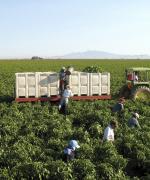
Paulig’s value chain is extensive: to almost all continents. The raw materials included in the study were plant-based: seeds, oil and spice plants, cereals and vegetables. The study will contribute to Paulig’s goal of halving its food loss by 2030.
Edible food potentially eliminated from the food supply chain due to quality requirements
Food loss refers to the removal of edible food from the food supply chain that is not used as feed or as another product with commercial value.
Loss is caused in the primary production of food for many reasons. In connection with harvesting, storage and transport, products are either removed from the chain or their quality may be impaired. Quality requirements can result in even edible food being removed from the food supply chain. Another potential cause of food loss is the market situation, overproduction in particular.
“To avoid loss, the correct timing of coffee and oil plant harvesting is especially important,” says Marja Roitto, who carried out the study.
Many of the raw materials included in the study are transported to storage and onward to the production chain as dry products, which usually means a good shelf life. In plant-based products, great annual variation is typical in terms of both yield and quality.
“This one-of-a-kind literature review helps us gain a global overview of the possible amount of losses for our key raw materials, as well as the root causes and information gaps. Based on these findings, we can carry out the necessary further investigations and plan future measures to reduce food loss and utilise sidestreams in Paulig's value chain,” says Lea Rankinen, director of sustainability and public affairs at Paulig.
Few extensive studies on food loss at the early stages of the food supply chain on the national level
“There are few sufficiently extensive studies on food loss at the national level in publication, and not enough information is available on all raw material groups,” Roitto says.
“This group includes coffee, oil plants as well as machine-threshed pumpkin seeds.”
In the case of cereals, vegetable oils and certain other raw materials, the geographic coverage of the data was insufficient. The causes of loss can relate to harvesting and processing, but developing countries also face the challenges of, for example, inadequate storage opportunities, long transport distances and market conditions. The development of skills, technical solutions and infrastructure in local agriculture is important.
“Supporting and training small producers is a central measure for reducing food loss in primary production,” Roitto suggests.
Investigating losses in primary production also has its challenges. According to Roitto, it was not always clear whether the food or other strata removed from the food supply chain were processed as waste or for other purposes.
Research-based knowledge on losses in coffee production is scarce
“Of the product groups studied, coffee beans, or coffee berries, originate in South and Central America, Africa and Asia,” Roitto says.
Annual production of green coffee beans is approximately 10.5 million tons, and such a high volume makes it sensible to investigate the actual amount of loss in more detail. A large share of coffee producers are small farms that carry out initial crop processing on their own.
“Even minor loss of raw material can be a substantial financial loss to these farms,” Roitto notes.
“Leônidas Carrijo Azevedo Melo, a researcher from Brazil, estimates that some 10–30% of coffee crops can fall from the plants to the ground. Attempts are made to harvest this part of the crop as well, but its quality is poorer,” says Roitto.
In most cases, the berry parts enclosing the coffee bean end up as waste. Today, new uses are being developed for coffee berries and bean husks, some of which are food applications, such as drinks.
“However, berries and bean husks are not included in the definition of food loss in primary production, as they are not considered edible food.”
The results will be published at Think Corner on 27 October at 10.00.
Further information:
Marja Roitto, +358 50 556 0504, marja.roitto@helsinki.fi
Lea Rankinen, director of sustainability and public affairs, Paulig, +358 41 539 4609, lea.rankinen@paulig.com
About Paulig
Paulig is a family-owned food and beverage company, growing a new, sustainable food culture – one that is good for both people and the planet. Paulig provides all things tasty; coffees and beverages, Tex Mex and spices, snacks and plant-based choices. The company's brands are Paulig, Santa Maria, Risenta, Gold&Green and Poco Loco. Paulig’s sales amounted to EUR 920 million in 2020. The company has over 2,000 passionate employees in 13 different countries working around the purpose For a life full of flavour.
www.pauliggroup.com
